Ever wondered about the identity of the wild dark goddess of Hindu culture? Here are the details of everything about ‘the dark-hued one’.
Who is Kali Maa?
Kali, also called Kalika and Kaalratri, is a Hindu Goddess that is the formidable and vicious form of Shakti (also known as Goddess Parvati, the consort of Shiva). She is the chief of the Maha Vidyas, a group of 10 Tantric Goddesses who each form a different aspect of Parvati/ Shakti. She is also regarded as the Goddess of Time, Destruction, and Power, one who protects the innocent and destroys the evil fiercely.
She is mostly portrayed in 2 forms- the usual 4-armed Kali form and the 10- armed Maha Kali form. Her skin is black or deep dark blue, with her eyes red in intoxication and rage. Her hair is often depicted as curly and disheveled, with her tongue rolling out of her mouth, and sometimes, small fangs protrude from the corners of her mouth. She wears a skirt made of arms or a tiger skin cloth covering her body, with a garland of either skulls or red hibiscus flowers.
When she is shown standing on the prostrate body of Shiva, jackals and serpents accompany her, drinking the blood dripping from the cut head of Raktabij in her hand to avoid more clones popping up. Despite her brutal form, she is often considered to be one of the kindest Goddesses for her devotees and a fierce protector from all evil forces.
Meaning of Kali
The word Kālī has 2 meanings- one is the feminine form of time, with the word Kāla as the masculine noun, and by extension, this means ‘the changing aspect of nature that rotates the cycle of life & death.’ The 2nd meaning is a female who has a dark skin tone. The meanings of her other names are:
- Kālarātri/ Kaalratri- the darkest black night
- Kālikā/ Kalika- the dark-hued/ skinned one
Another thing to note is that the homonym Kāla can signify both the words ‘time’ & ‘black’. According to experts at Online Temple, the history of Kali Maa is also related to the Mahabharata, where a female figure is carrying away the spirits of slain warriors and animals.
She is called Kali Maa, the dark mother. Also, since Kāla is an aspect (another form) of Shiva, Kali is considered to be Shiva’s consort (being a form of Goddess Parvati.
Story of Kali Maa
In the sixth century Devi Mahatmyam, Kali is shown as Maha Kali in the 1st chapter. She is born from the sleeping body of God Vishnu as Goddess Yog Nidra, to wake him up to protect Brahma and the world from the 2 demons Madhu and Kaitabha. Once Vishnu woke up, he started a long war against those demons but they were still undefeated and gloating in their success. Seeing this, Maha Kali took the form of Maha Maya and went to enchant the 2 demons. When they were distracted by Maha Maya, Vishnu killed them instantly.
In the later chapters, Chand and Mund were 2 demons who attack Goddess Durga. Durga responds with such ferocity that Kali emerges from her forehead and kills them both. Here, Kali is described as having dark blue skin, a gaunt face with sunken eyes, and wearing a tiger skin cloth with a garland of skulls.
Later in the same battle, the demon Raktabij, whose generals were Chand and Mund, faces Kali in battle. Raktabij has a boon that every drop of his blood that touches the ground will produce another of his clone. Since Durga is unable to defeat Raktabij with countless of his clones, Kali sucks his blood out of his body and devours his clones to defeat them.
In Linga Puran, the history of Kali Maa begins with Shiva asking Parvati’s help in defeating the demon Daruka, who was granted the boon that only a female could kill him. Parvati creates her form of Kali and goes on to defeat Daruka and his enemies.
In both cases of Raktabij and Daruka, Kali is described as being drunk on bloodlust after defeating the enemies and her craving for bloodlust gets out of control. Shiva has to intervene by laying calm on the floor. When Kali is marching in anger, she accidentally lays a foot on Shiva and her tongue rolls out. She immediately calms down and merges with Durga/ Parvati again.
In another story, Shiva teases Parvati by calling her Kali (dark-skinned) after she participated in a war. Parvati is greatly offended and begins to perform austerity for ages until she loses her dark complexion, sheds it, and becomes Gauri, the golden-skinned goddess. Her shed dark sheath becomes Kaushiki, who when enraged becomes Kali.
Kali Puja Festival

Kali Puja festival is dedicated to Goddess Kali and celebrated especially in Indian regions of West Bengal, Odisha, and Assam. It is celebrated on the day of the new moon (Dipannita Amavasya) in the month of Kartik of the Hindu calendar. It starts after Diwali and goes on for 10 days. Since Goddess Kali is the chief of 10 Maha Vidyas, each of them has a day of incarnation before the Kali Puja.
In West Bengal, Kali Puja is celebrated with great energy, according to Online Temple experts. Lavish pandals with unique & dazzling lighting are built; clay statues and idols are handcrafted and decorated beautifully, & worship of Kali Maa is done in both homes and pandals.
In Brahman style worship, Kali Puja is done in the day, with offerings of red hibiscus flowers, and food and sweets made of lentils, rice, and fruits online temple services are held in this style of worship). In Tantric worship, ritual sacrifice of animals is offered (mostly goats), and devotees are said to be in meditation from night to dawn, usually in cremation grounds as it is said to be the abode of Kali Maa.
Kali Maa is offered a prasad of fruits, Khichuri/ Khichdi Bhog in Bengal with Niramish Mangsho (that is, mutton without onion or garlic), Fish Curry, Payesh (dessert), and Bhaja (deep-fried fritters). In some places, alcohol is also offered as a prasad.
Experienced pandits at Online Temple say that people visit the pandals throughout the night, and crowds increase at night as compared to the day. The puja is celebrated with astounding lights, light & sound shows, theater, magic shows, and fireworks.
With the incarnation of Maha Vidyas celebrated each day before Kali Puja and the incarnation of the last Maha Vidya, Kamalatmika, known as Kamalatmika Jayanti, falling on the day of Diwali, she is often considered as Tantric Lakshmi.
Due to this and the fact that Lakshmi is known to be Vishnu’s consort, the rest of the Indian regions celebrate Diwali as a festival related to Vaishnavism. They worship Goddess Maha Lakshmi as the supreme mother goddess presiding over them.
However, in the Eastern & Northeastern regions, with the Kalikuli Shakta faith being dominant, people worship Goddess Kali as she is the root of Kamalatmika. Apart from Durga Puja, Kali Puja is the 2nd biggest festival in West Bengal and Assam.
Kali Puja
On this day, devotees bring a clay statue/ idol (made of other materials) into their homes. After cleaning the place where it is going to be kept for the duration of the puja properly, the idols/ statues/ statuettes are installed in the place with abundant festive energy. The statues are cleansed and bathed with water or holy water is sprinkled if they are made of clay.
After that, it is decorated with red hibiscus flowers and a hibiscus garland, which are believed to be her favorite flower. Then, Kali puja is done in pandals with the help of Kali mantras and hymns, offering her prayers and invoking her divinity. If the puja is being held at home, Online Temple offers online puja booking services of Kali Puja, where the pujas are held through live meeting on Zoom video call on the devotee’s behalf.
The pandits of Online Temple have all the samagri ready for the puja and all that the devotees need to do is follow certain instructions, which are sent by Online Temple through e-mail. Once the puja has been conducted, Pushpaanjali is offered to the goddess and Bhog is next. Many delicacies are cooked as part of the Bhog, which after being offered to the goddess, is distributed amongst devotees.
Kali Puja Benefits
- Eradicates suffering as a result of nefarious causes.
- Destroys negative energies in and around the house.
- Brings peace & prosperity to the household.
- Protects from all evil forces against the devotee(s).
- Increases health & mental relaxation of the devotee.
- Amplifies wealth & removes debt and money troubles.
Kali Mantra
Bija Mantra:
Kreem
Simple Form Of Kali Mantra:
Om Kreem Kali
Kali Mantra:
Om Kring Kalikaye Namah
Simple Kali Mantra:
Om Sri Maha Kalikayai Namaha
Kalika-Yei Mantra:
Om Klim Kalika-Yei Namaha
The Fifteen Syllable Mantra:
Om Hrim Shreem Klim Adya Kalika Param Eshwari Swaha
Kali Mantra For Worship:
Kring Kring Kring Hing Kring Dakshine Kalike
Kring Kring Kring Hring Hring Hung Hung Swaha
Kali Gayatri:
Om Maha Kalyai
Ca Vidmahe Smasana Vasinyai
Ca Dhimahi Tanno Kali Prachodayat
Kali Chants:
- Om Kali, Kali! Om Kali, Kali!
Namostute, namostute, namo!
Namostute, namostute, namo!
- Ananda Ma Ananda Ma Kali
Ananda Ma Ananda Ma Kali
Ananda Ma Ananda Ma Kali
Om Kali Ma!
Dakshina Kali Dhyan Mantra/ Karpuradi Stotram:
Om karala-badanam ghoram mukta-keshim chatur-bhuryam.
kalikam dakshinam dibyam munda-mala bibhushitam
sadya-chinna shira kharga bama-dordha karambujam
abhayam baradan-chaiba dakshina-dardha panikam
Maha Kali Dhyanam:
Om khargang chakra-gadeshu-chapa-parighan shulang bhushundIng shirah shankhang sanda-dhatIng karistri-nayanang sarbanga-bhushabritam. nIlashma-dyutimasya pada-dashakang sebe maha kalikang yamastou-chhaite harou kamalajye hantung madhung kaitavam.
Kali Mantra Benefits
- Receive sanctuary and blessings of Kali Maa.
- Gets rid of the fear of death and accidents.
- Improve knowledge & wisdom in oneself.
- Rapid growth of spirituality in devotees.
- Relief from all negative situations in life.
- Enhances consciousness and positivity.

Also Read :- Story of Lord Brahma | The Creator of The Universe

